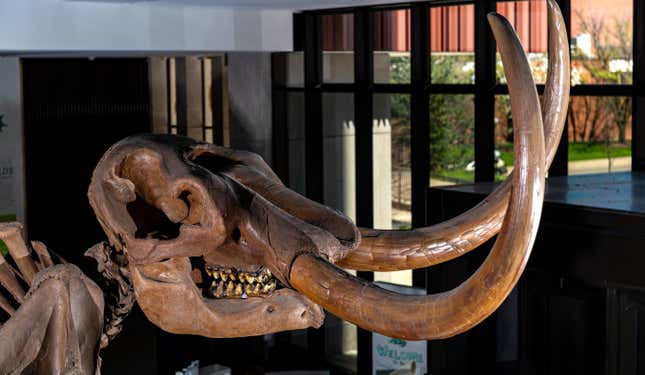
Researchers have detailed the life and grisly death of a male mastodon that died 13,200 years ago by scrutinizing the chemical composition of one of its tusks. The tusk revealed the mastodon grew up in the Great Lakes area and, later in life, made annual trips to a mating ground in northeastern Indiana—until it died there at age 34, after being stabbed in the face by another mastodon.
Mastodons (Mammut americanum) were proboscideans that roamed across North America before their extinction around 11,000 years ago. The animals’ migration patterns have previously been investigated using isotopes locked away in their tooth enamel, but the recent investigation of one individual’s right tusk shows in detail how male mastodons’ movements would change as the animals matured. The team’s research is published in the Proceedings of the National Academy of Sciences.
“Certainly for mastodons, there’s never been a study to look at changes in landscape use within an individual’s lifetime over many, many, many years, and certainly none that have indicated that there are annual migrations that are seasonally driven,” Joshua Miller, a paleoecologist at the University of Cincinnati and lead author of the study, told Gizmodo in a phone call.
The animal the team studied is called the Buesching mastodon, after the family who owns the land on which it was found (and who later donated the specimen to the Indiana State Museum). It’s nicknamed Fred, after a member of the Buesching family.
Though Fred (the mastodon) died over 13,000 years ago, the details of its travels could still be lifted from isotopes in its 9.5-foot tusk.
Isotopes of elements like oxygen and strontium have natural abundances that differ across time and location. Because those elements end up in soils and waterways, living things (mastodons, humans, Neanderthals—you name it) consume them, offering researchers a way of tracking the movements of ancient beings. Because mastodon tusks are really elongated teeth, the same scientific techniques can be applied to them.

Based on the isotopes in the tusk, the term determined that the male mastodon began to roam the Great Lakes area when it separated from its herd at 12 years old. (Some elephant herds today are matriarchal; mastodon herds may have functioned the same way.)
“There’s this growth of home range as the animal goes through adolescence,” Miller said. “As [an adult] male, it’s doing something very, very different than it was when the young male was in closer proximity to the maternal herd.” Fred died nearly 100 miles from its home territory, indicating the large range of the 8-ton adult.
Before this study, researchers knew “basically bupkis” about how individual extinct animals interacted with their environment seasonally, Miller said, and for mastodons, life revolved around seasonal change.
Like elephants, female mastodons had long gestation periods of about 22 months. Females would give birth to big baby mastodons in spring, to ensure their young could take in as many nutrients as possible before the next winter set in.
Males also would try to find mates in the spring—hence how the recently studied mastodon ended up in what is today northeastern Indiana. According to Daniel Fisher, a paleontologist at the University of Michigan, even if a fight between male mastodons wasn’t fatal (as was the case with Fred), when male mastodons fought, their tusks would basically twist in their sockets, stunting the growth of nascent cells at the base of the tusks.
“Every time spring comes around, we get an arc of these defects that that represents tusk damage [in male specimens],” Fisher said. The team could read the tusks chronologically, and they were able to line up springtime with the damage incurred by battles with competitors.

The team found that Fred went to the same place in Indiana annually in the last three years of its 34-year life. They also confirmed that Fred never ventured to that region before adulthood—further evidence that this may have been a mating ground. Fred’s last trip ended with a fatal fight with another male, based on the puncture wound in the side of its head.
“I’ve got at least a half-dozen individuals that have the same kind of hole in the same place, sometimes on the left, sometimes on the right—in one awful case, on both sides,” Fisher said, indicating the extent to which combat was a regular part of mastodon life.
These findings “squarely fit” with what others have theorized about how mastodons roamed, Miller said.
Now, the researchers plan to study the isotopes in other tusks, to get a better sense of how mastodons migrated more generally and whether the specimen from Indiana had a typical or superlative amount of miles on its stocky legs. Future work may show if Fred was the rule or an exception for how male mastodons lived.
More: Monumental DNA Study Reveals Secrets of North American Mastodons